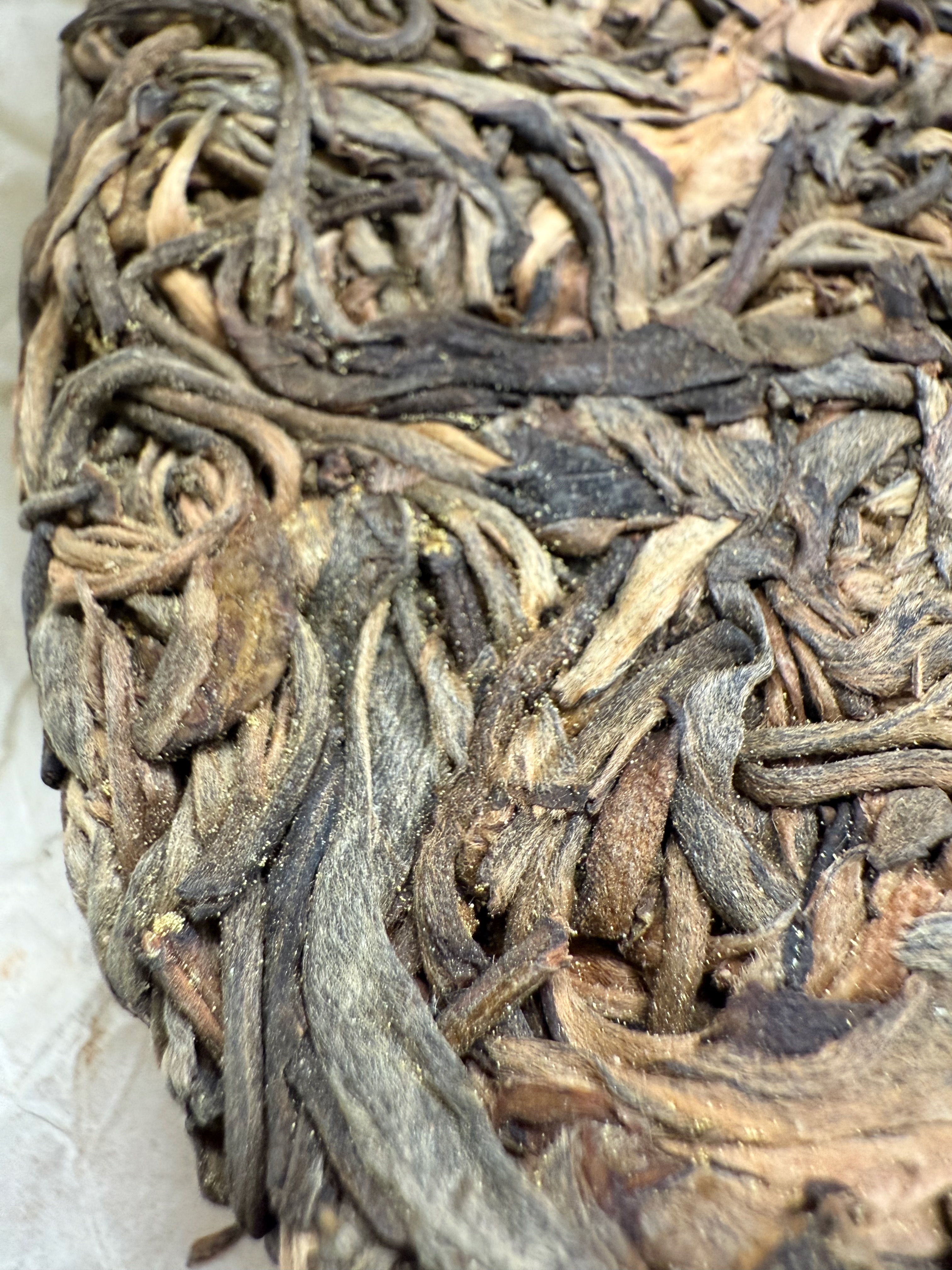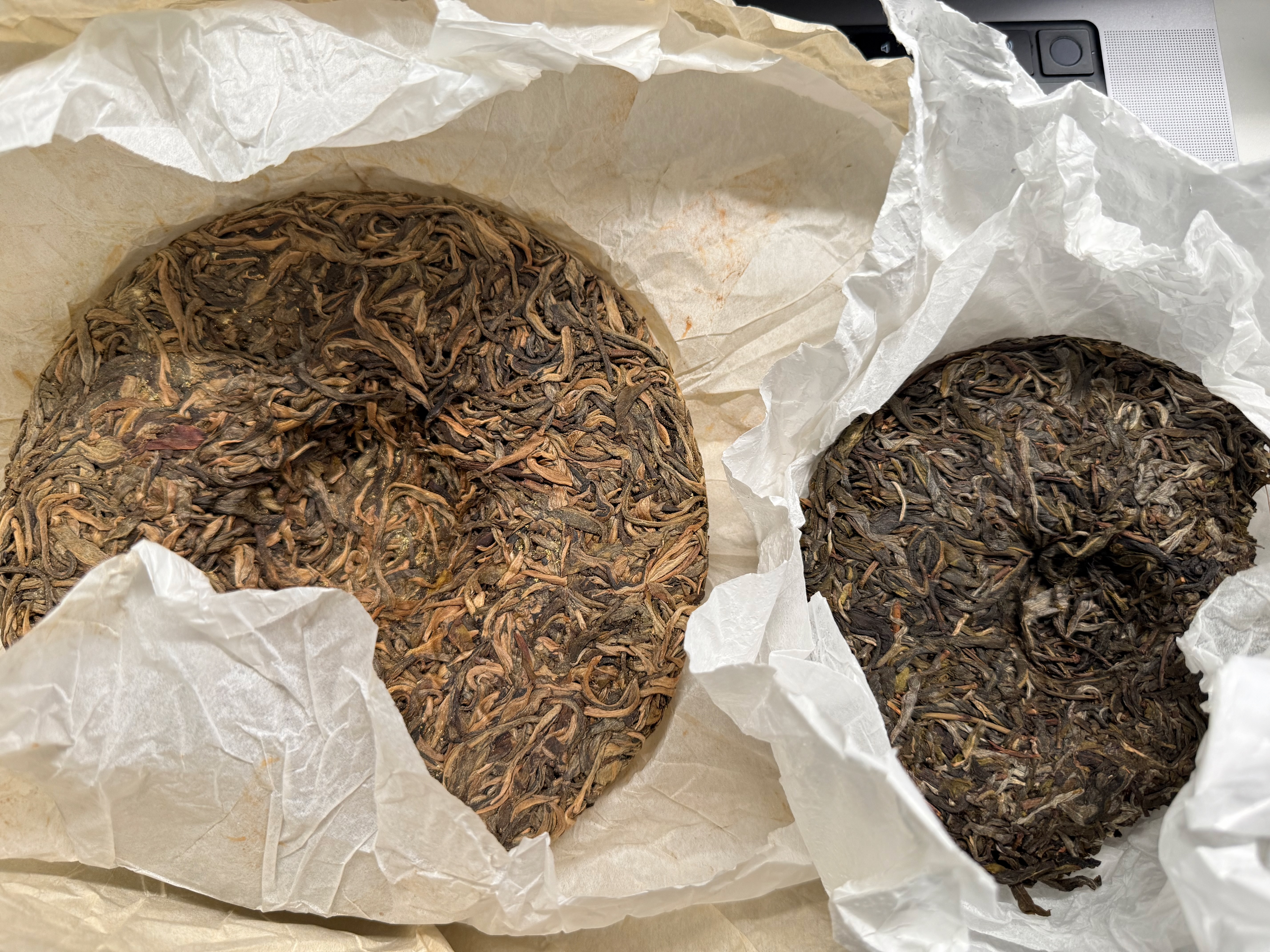This is rather interesting. I got a new cake today and the cake had a yellow tone and had yellow spots.
The Discovery
Got this 2024 pu-erh today in the mail - the cake is slightly yellow in color and has yellow dots on it. I looked at some forum posts and apparently there are two types of fungi - one bad and one that adds to flavor.

Overall the cake is more yellow than expected. Here are some high-quality images showing the extent of the discoloration:


Merchant Response
The merchant from Taobao was nice enough to inform me that this batch was bad (he said just checked his batch today and said he found some of the cakes were bad) and offered a refund.
Link to my thoughts on the merchant: Bulang Farmer Livestream - Vendor Review
Research Notes
After some research, I found the following:
- there are many different strains of fungi and bacteria that can grow - and it’s difficult to identify the strains without advanced techniques (no simple assays)
- The biggest health concern is mycotoxins produced by fungi - and unless you do the test for the species involved, it’s hard to know how much mycotoxins are present. On top of this mycotoxics cannot be simply removed by boiling water etc - this is the biggest reason why some people think moldy tea causes cancer etc.
- Research on tea is very complex due to the fact many species of fungi / bacteria can grow, and the mixture of species can change over time. This is one of the reasons why there is so much conflicting information.
Some references: Liu JY, He D, Xing YF, Zeng W, Ren K, Zhang C, Lu Y, Yang S, Ou SJ, Wang Y, Xing XH. Effects of bioactive components of Pu-erh tea on gut microbiomes and health: A review. Food Chem. 2021 Aug 15;353:129439. doi: 10.1016/j.foodchem.2021.129439. Epub 2021 Mar 3. PMID: 33743430. Chemical constituents and biological properties of Pu-erh tea https://www.sciencedirect.com/science/article/pii/S0963996921007997 https://www.sciencedirect.com/science/article/pii/S2405844024043925
I wanted to save this blog post for future reference since I found some previous research on this topic - but didn’t really have enough information on them.
Golden Flower Fungus in Pu-erh Tea Introduction “Golden flower” (金花, Jin Hua) refers to a visible fungal growth often found in certain fermented dark teas, such as Fu brick tea, which is closely related to Pu-erh tea. This fungus appears as golden-yellow specks or blooms on the tea leaves during the post-fermentation process. Based on academic papers and related sources, the primary fungus responsible is Eurotium cristatum (also sometimes referred to as Aspergillus cristatus in its anamorph form). It plays a key role in the microbial fermentation, enhancing flavor, aroma, and potential health benefits of the tea.xiahepublishing.com
What Fungus Is It? Eurotium cristatum is a xerophilic fungus commonly isolated from Fu brick tea and other dark teas like Pu-erh. It is the dominant strain in the “blooming” or “flowering” stage of fermentation, where it forms the characteristic golden spores. Key findings from academic papers include:
It contributes to the metabolic improvements in tea, such as altering chemical compositions (e.g., catechins, amino acids) and producing unique fungal floral aromas.sciencedirect.com In studies on Pu-erh and similar teas, E. cristatum is inoculated to facilitate solid-state fermentation, leading to enhanced flavor profiles and quality indicators like lipid-lowering compounds.pmc.ncbi.nlm.nih.gov Related species like Eurotium repens have been identified in some Yunnan jinhua teas, but E. cristatum remains the primary “golden flower” fungus.researchgate.net Its spore content is used as a quality marker in fermented teas, with higher amounts correlating to better tea grades.sciencedirect.com This fungus is intentionally encouraged in traditional production processes for dark teas, distinguishing it from unwanted molds.
Is It Harmful? Eurotium cristatum is generally considered safe and non-harmful when present in properly fermented teas. In fact, it is viewed as beneficial:
It is non-toxic and contributes to probiotic-like effects, antioxidants, and health benefits such as alleviating metabolic disorders or preventing oxidative stress in hair follicles.orientaleaf.comorientaleaf.com Community discussions and reviews confirm it as a recognizable, safe mold specific to these teas, unlike random or harmful yellow molds that might appear on improperly stored Pu-erh.steepster.comteachat.com Studies on its application in herbal teas and dark teas show no adverse effects; instead, it enhances nutritional value, such as lipid-lowering activity and improved fermentation quality.pmc.ncbi.nlm.nih.govpmc.ncbi.nlm.nih.gov No academic papers reviewed indicate toxicity or harm from E. cristatum in tea contexts; it is often highlighted for its positive role in bioremediation and food fermentation.researchgate.net However, as with any fermented product, improper storage could lead to contamination by other molds, which should be avoided. Always source from reputable producers.